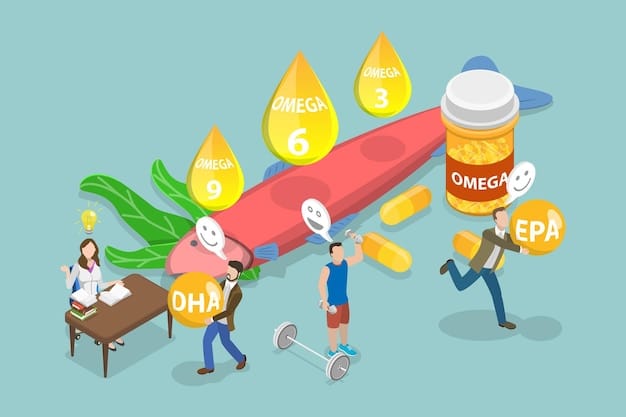FDA Sodium Guidelines 2025: Impact on Your Heart Health

The new FDA guidelines on sodium intake, set to influence dietary habits by 2025, aim to significantly reduce sodium consumption in the US population, potentially leading to improved cardiovascular health and a decreased risk of heart-related diseases.
Are you concerned about your heart health and the amount of sodium in your diet? The **How Can the New FDA Guidelines on Sodium Intake Impact Your Heart Health in 2025?** is a crucial question for anyone looking to maintain a healthy lifestyle. Let’s dive in to understand the impact of these guidelines on your well-being.
Understanding the FDA’s New Sodium Guidelines
The Food and Drug Administration (FDA) has introduced new guidelines aimed at reducing sodium intake across the US population. These guidelines are designed to encourage food manufacturers and restaurants to lower the amount of sodium in their products, with the ultimate goal of improving public health.
Sodium, while essential in small amounts for bodily functions, is often consumed in excess. This overconsumption can lead to a variety of health problems, including hypertension, heart disease, and stroke. Recognizing these risks, the FDA has taken a proactive approach to address this critical issue.
The Rationale Behind the Guidelines
The FDA’s new guidelines are based on extensive scientific research demonstrating the adverse effects of high sodium intake on heart health. By setting targets for sodium reduction, the FDA hopes to create a food environment that supports healthier dietary choices.
Key Objectives of the Guidelines
- Reduce the average sodium intake to the recommended level.
- Encourage food manufacturers to reformulate products with less sodium.
- Promote consumer awareness of sodium content in foods.
- Improve overall public health outcomes related to heart disease.
By implementing these guidelines, the FDA aims to create a food supply that makes it easier for Americans to adhere to recommended sodium levels, fostering better heart health outcomes in the long run. These objectives reflect a commitment to proactive public health interventions.
In conclusion, the FDA’s new sodium guidelines are a significant step towards promoting heart health by reducing excessive sodium consumption. By setting clear targets and encouraging industry participation, the FDA aims to create a healthier food environment for everyone.
The Science Behind Sodium and Heart Health
The connection between sodium intake and heart health is well-established through numerous scientific studies. Understanding this connection is crucial for appreciating the significance of the FDA’s new guidelines.
Sodium plays a vital role in regulating blood pressure and maintaining fluid balance in the body. However, excessive sodium intake can disrupt these processes, leading to hypertension and increased risk of cardiovascular events.

How Sodium Affects Blood Pressure
When you consume too much sodium, your body retains more water to maintain the right sodium concentration in your blood. This increased water retention leads to a higher blood volume, which in turn increases blood pressure.
Long-Term Effects of High Sodium Intake
Over time, sustained high blood pressure can damage the heart and blood vessels, increasing the risk of heart disease, stroke, and kidney problems. The heart has to work harder to pump blood, leading to potential enlargement and weakening of the heart muscle.
- Increased risk of hypertension.
- Higher chance of developing heart failure.
- Elevated risk of stroke.
- Potential for kidney damage.
These long-term effects highlight the importance of managing sodium intake to protect heart health. Reducing sodium consumption can lead to lower blood pressure and a decreased risk of these serious health conditions.
In summary, the scientific evidence linking sodium intake to heart health is compelling. By regulating blood pressure and reducing strain on the cardiovascular system, managing sodium consumption is essential for preventing heart disease and promoting overall well-being.
How the 2025 Guidelines Aim to Reduce Sodium Intake
The FDA’s 2025 guidelines aim to substantially reduce sodium intake across the US population by setting specific targets for the food industry. These targets are designed to gradually lower the amount of sodium in processed foods, which are a major source of dietary sodium.
The guidelines focus on a population-wide approach, recognizing that individual behavior change alone is not sufficient to achieve meaningful reductions in sodium intake. By working with food manufacturers and restaurants, the FDA hopes to create a food environment that supports healthier choices.
Specific Targets for Sodium Reduction
The FDA has established short-term and long-term targets for sodium reduction in various food categories. These targets are based on the best available scientific evidence and are designed to be achievable and measurable.
Strategies for Food Manufacturers
Food manufacturers are encouraged to use a variety of strategies to reduce sodium in their products, including reformulation, ingredient substitution, and portion size reduction. These strategies can help lower sodium levels without compromising taste or quality.

- Reformulating products with lower-sodium ingredients.
- Using sodium alternatives to maintain flavor.
- Reducing portion sizes to decrease overall sodium intake.
- Providing clear and accurate labeling of sodium content.
By implementing these strategies, food manufacturers can play a crucial role in helping Americans reduce their sodium intake and improve their heart health. Clear labeling also empowers consumers to make informed choices.
In conclusion, the FDA’s 2025 guidelines provide a roadmap for reducing sodium intake by setting specific targets for the food industry and encouraging innovative strategies. By working collaboratively, the FDA and food manufacturers can create a healthier food environment for the US population.
Impact on Heart Health: What to Expect in 2025
The implementation of the FDA’s new sodium guidelines is expected to have a significant positive impact on heart health by 2025. As sodium levels in processed foods decrease, individuals will likely experience lower blood pressure and a reduced risk of cardiovascular events.
These improvements in heart health are essential for reducing the burden of heart disease, which remains a leading cause of death and disability in the United States. The guidelines aim to prevent thousands of heart attacks, strokes, and cases of heart failure each year.
Projected Health Benefits
Experts predict that the widespread adoption of the FDA’s guidelines could lead to a substantial reduction in the incidence of hypertension and related cardiovascular diseases. This would result in significant cost savings for the healthcare system and improved quality of life for many Americans.
Potential Challenges and Mitigation Strategies
While the potential benefits are considerable, there are also challenges to consider, such as consumer acceptance of lower-sodium products and the need for ongoing monitoring and evaluation. Addressing these challenges will be crucial for maximizing the impact of the guidelines.
- Ensuring continued consumer acceptance of lower-sodium foods.
- Monitoring the effectiveness of the guidelines through data collection.
- Addressing disparities in sodium intake among different populations.
- Providing education and support to help individuals reduce sodium intake.
By proactively addressing these challenges, policymakers and health professionals can ensure that the FDA’s guidelines achieve their intended goals and lead to lasting improvements in heart health. Consistent monitoring and adaptable strategies are key.
In summary, the implementation of the FDA’s new sodium guidelines is expected to have a wide-ranging positive impact on heart health by 2025. By reducing sodium intake and lowering blood pressure, these guidelines have the potential to save lives and improve the well-being of millions of Americans.
How to Monitor and Reduce Your Own Sodium Intake
While the FDA’s guidelines focus on influencing the food supply, individuals can also take proactive steps to monitor and reduce their own sodium intake. By making informed food choices and adopting healthy eating habits, you can significantly lower your sodium consumption and protect your heart health.
Reading food labels, cooking at home, and choosing fresh, unprocessed foods are effective strategies for managing sodium intake. Small changes in your daily routine can make a big difference in your overall health.
Tips for Reading Food Labels
Pay close attention to the sodium content listed on food labels. Look for products labeled “low sodium,” “reduced sodium,” or “no salt added.” Be aware of serving sizes and adjust your intake accordingly.
Strategies for Cooking at Home
When cooking at home, use fresh ingredients and avoid adding salt. Experiment with herbs, spices, and other flavor enhancers to season your food. Prepare larger portions and freeze leftovers for future meals.
- Read food labels carefully.
- Cook at home more often.
- Choose fresh, unprocessed foods.
- Use herbs and spices instead of salt.
By implementing these strategies, you can take control of your sodium intake and improve your heart health. Small changes in your eating habits can add up to significant long-term benefits.
In conclusion, monitoring and reducing your own sodium intake is a proactive way to protect your heart health. By reading food labels, cooking at home, and choosing fresh foods, you can lower your sodium consumption and enjoy a healthier lifestyle.
The Role of Public Awareness and Education
Public awareness and education are essential for the successful implementation of the FDA’s new sodium guidelines. By increasing awareness of the health risks associated with high sodium intake and providing practical tips for reducing sodium consumption, public health campaigns can empower individuals to make informed choices.
Schools, community organizations, and healthcare providers all have a role to play in disseminating information and promoting healthy eating habits. Collaborative efforts are needed to reach diverse populations and ensure that everyone has access to the knowledge and resources they need to protect their heart health.
Effective Public Health Campaigns
Public health campaigns should use clear and concise messaging to communicate the importance of reducing sodium intake. These campaigns should also provide practical tips for reading food labels, cooking at home, and choosing healthier options when eating out.
The Importance of Educating Children
Educating children about the importance of healthy eating habits is crucial for preventing heart disease later in life. Schools can incorporate nutrition education into the curriculum and promote healthy food choices in the cafeteria.
- Clear and concise messaging in public health campaigns.
- Nutrition education in schools.
- Community-based interventions to promote healthy eating.
- Collaboration between healthcare providers and public health organizations.
By investing in public awareness and education, we can create a culture of health that supports the FDA’s new sodium guidelines and improves the heart health of future generations. A comprehensive approach is vital for lasting impact.
In summary, public awareness and education are critical for the success of the FDA’s new sodium guidelines. By empowering individuals to make informed choices and promoting healthy eating habits from a young age, we can create a healthier society and reduce the burden of heart disease.
| Key Aspect | Brief Description |
|---|---|
| 🎯 FDA Guidelines | Targets to reduce sodium in processed foods by 2025. |
| ❤️ Heart Health | Lower sodium intake reduces blood pressure and heart disease risk. |
| 🧂 Reduce Intake | Read labels, cook at home, and choose fresh foods. |
| 📣 Public Awareness | Education empowers informed choices for better health. |
Frequently Asked Questions
The primary objective is to reduce sodium intake across the US population to improve heart health and lower the risk of cardiovascular diseases.
Excessive sodium can elevate blood pressure, straining the heart and increasing the risk of heart attacks, strokes, and other heart-related conditions.
They can reformulate products with lower-sodium ingredients, use sodium alternatives, and reduce portion sizes while ensuring products remain appealing to consumers.
By reading food labels carefully, cooking meals at home using fresh ingredients, and avoiding processed foods, individuals can effectively track and manage their sodium consumption.
Public education is crucial in raising awareness about the dangers of high-sodium diets and providing practical tips for making healthier choices, ultimately promoting better cardiovascular health.
Conclusion
The FDA’s forthcoming sodium guidelines represent a pivotal stride toward enhancing heart health across the US. By strategically curbing sodium levels in processed foods and galvanizing public awareness, these measures promise to significantly diminish the specter of heart disease. As 2025 approaches, embracing these guidelines, combined with personal vigilance, heralds a future of improved well-being and cardiovascular resilience for all.





